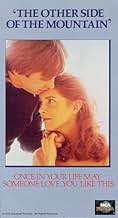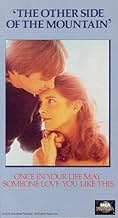PUNTUACIÓN EN IMDb
6,4/10
1,3 mil
TU PUNTUACIÓN
Una prometedora niña ver cómo su carrera como esquiadora queda bruscamente interrumpida por el cruel destino.Una prometedora niña ver cómo su carrera como esquiadora queda bruscamente interrumpida por el cruel destino.Una prometedora niña ver cómo su carrera como esquiadora queda bruscamente interrumpida por el cruel destino.
- Nominado para 1 premio Óscar
- 1 premio y 4 nominaciones en total
Belinda Montgomery
- Audra Jo
- (as Belinda J. Montgomery)
William Bryant
- Bill Kinmont
- (as Bill Bryant)
Argumento
¿Sabías que...?
- CuriosidadesDuring filming, news reached Jill Kinmont that her cousin Jimmy Lewis, who had visited her during her hospitalization nineteen years before, suffered a spinal cord injury in a fall and was paralyzed.
- PifiasDuring her fall Jill loses both ski poles. When the paramedics reach her, they are in her hands and they have to pry them off.
- Citas
[Reflecting on her life after the loss of her fiance]
Jill Kinmont: I try not to let it, but sometimes it all plays back in my mind, and when it does, I remember the words that Dick Buek said to me the last time I saw him: "How lucky I am to have found someone and something that saying goodbye to is so damned awful."
- ConexionesFollowed by The Other Side of the Mountain: Part II (1978)
- Banda sonoraRichard's Window
AKA in the UK as "A Window to the Sky"
Music by Charles Fox
Lyrics by Norman Gimbel
Sung by Olivia Newton-John
[Played over the end credits]
Reseña destacada
The early to mid 1970s were an interesting time for movie-making and some of the films from that era can be fun to re-visit. While not on a par with Summer of '42 or Love Story, this film has some charms that make it worth another look.
Made to reach for some of the box office success of the syrupy romance Love Story, The Other Side of the Mountain tells the true story of Jill Kinmont, the teen-aged downhill skier with Olympic gold in her sights who's dealt a full Kleenex box worth of tragedies.
Beautiful cinematography (although the prints I've seen lately have been dirty) takes us through her 1950s teenhood in the Eastern Sierras, full of boys, BFFs and her steely determination to win in high school ski meets.
Although the tale of a vivacious girl becoming crippled is one of the biggest clichés in movies, Jill's paralyzing injury, the result of a ski race, is still memorable. In a fall on the slopes (staged unconvincingly by turning the camera on its side) Jill goes from hard-charging athlete to high-level quadriplegic, paralyzed from her chest down, left with no use of her hands, and dependent on others for every basic and intimate task.
We see her imprisoned in traction, straining to move her wheelchair, helpless in a swimming pool, fretting about the medical corset that keeps her upright before a visit from her then boyfriend. But through Marilyn Hassett's portrayal, we see the same strength and determination that made her a ski champ re-emerge as she learns to live her new life on wheels. She pushes to complete her education and fights to become the first paralyzed teacher in the state. Throughout, she's supported by her family and the James Dean-ish hot-dog skier, Dick Buek, played by Beau Bridges in a likable performance. Buek spares Jill the hand-wringing weepy treatment over her plight and instead challenges her to make a life with what's she's got left. Which, it turns out, is a lot.
This movie overall is not one for the ages. Larry Peerce and the scriptwriter (David Seltzer, whose next film was The Omen!) never stray from the formula, and give their actors some very stilted lines to work with. But instead, look in the corners – look at Marilyn Hassett's moments of flint underneath the pink sweaters and girly vulnerability. Look at Beau Bridges's squinty grins and twitchy physicality. Think about what it takes to turn the page on an athletic life and live in a body that you can't feel, facing each day in an electric wheelchair. And reflect that it's the story of a real person.
Unfortunately this Universal release seems to have dropped off the face of the earth: I haven't seen it on any TV schedule in a long time, the VHS release is out of print and there's no DVD in site. I'm beginning to think it was a casualty of Universal's film vault fire in 2008, although the studio claims it had copies of everything. This movie was the 9th top-grossing film the year it was released, just ahead of Tommy.
Made to reach for some of the box office success of the syrupy romance Love Story, The Other Side of the Mountain tells the true story of Jill Kinmont, the teen-aged downhill skier with Olympic gold in her sights who's dealt a full Kleenex box worth of tragedies.
Beautiful cinematography (although the prints I've seen lately have been dirty) takes us through her 1950s teenhood in the Eastern Sierras, full of boys, BFFs and her steely determination to win in high school ski meets.
Although the tale of a vivacious girl becoming crippled is one of the biggest clichés in movies, Jill's paralyzing injury, the result of a ski race, is still memorable. In a fall on the slopes (staged unconvincingly by turning the camera on its side) Jill goes from hard-charging athlete to high-level quadriplegic, paralyzed from her chest down, left with no use of her hands, and dependent on others for every basic and intimate task.
We see her imprisoned in traction, straining to move her wheelchair, helpless in a swimming pool, fretting about the medical corset that keeps her upright before a visit from her then boyfriend. But through Marilyn Hassett's portrayal, we see the same strength and determination that made her a ski champ re-emerge as she learns to live her new life on wheels. She pushes to complete her education and fights to become the first paralyzed teacher in the state. Throughout, she's supported by her family and the James Dean-ish hot-dog skier, Dick Buek, played by Beau Bridges in a likable performance. Buek spares Jill the hand-wringing weepy treatment over her plight and instead challenges her to make a life with what's she's got left. Which, it turns out, is a lot.
This movie overall is not one for the ages. Larry Peerce and the scriptwriter (David Seltzer, whose next film was The Omen!) never stray from the formula, and give their actors some very stilted lines to work with. But instead, look in the corners – look at Marilyn Hassett's moments of flint underneath the pink sweaters and girly vulnerability. Look at Beau Bridges's squinty grins and twitchy physicality. Think about what it takes to turn the page on an athletic life and live in a body that you can't feel, facing each day in an electric wheelchair. And reflect that it's the story of a real person.
Unfortunately this Universal release seems to have dropped off the face of the earth: I haven't seen it on any TV schedule in a long time, the VHS release is out of print and there's no DVD in site. I'm beginning to think it was a casualty of Universal's film vault fire in 2008, although the studio claims it had copies of everything. This movie was the 9th top-grossing film the year it was released, just ahead of Tommy.
- jTube
- 15 sept 2009
- Enlace permanente
Selecciones populares
Inicia sesión para calificar y añadir a tu lista para recibir recomendaciones personalizadas
- How long is The Other Side of the Mountain?Con tecnología de Alexa
Detalles
- Fecha de lanzamiento
- País de origen
- Idioma
- Títulos en diferentes países
- The Other Side of the Mountain
- Localizaciones del rodaje
- Empresa productora
- Ver más compañías en los créditos en IMDbPro
Taquilla
- Recaudación en Estados Unidos y Canadá
- 34.673.100 US$
- Duración1 hora 42 minutos
- Relación de aspecto
- 1.85 : 1
Contribuir a esta página
Sugerir un cambio o añadir el contenido que falta

Principal laguna de datos
By what name was Una ventana al cielo (1975) officially released in India in English?
Responde

































